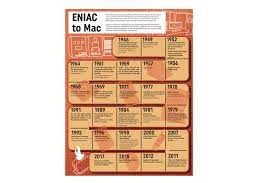
The Evolution of Computers from ENIAC to Present Technology
Computers have come a long way since the days of the ENIAC, the first general-purpose electronic digital computer that was completed in 1945. The journey from the massive and slow machines of the mid-20th century to the sleek and powerful devices we use today is a fascinating one.
After ENIAC, computers continued to evolve rapidly. The invention of transistors in the late 1940s paved the way for smaller, faster, and more reliable computers. This led to the development of mainframe computers in the 1950s and 1960s, which were used by large organizations for data processing tasks.
In the 1970s, the era of personal computing began with machines like the Altair 8800 and Apple I. These early computers were primitive by today’s standards but laid the groundwork for what was to come. The introduction of microprocessors in the early 1970s revolutionized computing by allowing for smaller and more affordable machines.
The 1980s saw the rise of home computers like the Commodore 64 and IBM PC, bringing computing power into people’s homes. The graphical user interface (GUI) introduced by Apple’s Macintosh in 1984 made computers more user-friendly and accessible to a wider audience.
The 1990s brought about significant advancements in computer technology, including faster processors, larger storage capacities, and widespread internet connectivity. This laid the foundation for the digital age we live in today.
Today’s computers are faster, more powerful, and more connected than ever before. The advent of smartphones, tablets, and cloud computing has further transformed how we interact with technology on a daily basis.
As we look back on the evolution of computers from ENIAC to present technology, it is clear that we have come a long way in a relatively short period. The pace of technological advancement shows no signs of slowing down, promising an exciting future filled with even more innovation and possibilities.
“Tracing the Milestones: The Evolution of Computer Technology From Its Inception to Today”
3. “From ENIAC to the Modern
- What came after the ENIAC computer?
- What is the evolution of computer technology?
- What is ENIAC and explain its evolution to modern computer?
- What are the 5 evolutions of computer?
What came after the ENIAC computer?
After the ENIAC computer, the evolution of computing technology saw the development of smaller, faster, and more reliable machines. The invention of transistors in the late 1940s paved the way for mainframe computers in the 1950s and 1960s, which were utilized by large organizations for data processing tasks. The introduction of microprocessors in the early 1970s revolutionized computing, leading to the era of personal computing with machines like the Altair 8800 and Apple I. Subsequent advancements in computer technology throughout the decades have brought us to today’s era of powerful and interconnected devices that have become integral parts of our daily lives.
What is the evolution of computer technology?
The evolution of computer technology traces a remarkable journey from the era of the ENIAC, the first general-purpose electronic digital computer developed in 1945, to the cutting-edge technologies of the present day. Over the decades, computers have undergone significant advancements in terms of size, speed, processing power, and connectivity. From the introduction of transistors and microprocessors to the rise of personal computing and the internet age, each milestone has propelled computer technology forward, shaping how we work, communicate, and interact with information. Today’s computers are faster, more powerful, and more versatile than ever before, reflecting a continuous evolution driven by innovation and technological progress.
What is ENIAC and explain its evolution to modern computer?
The ENIAC, short for Electronic Numerical Integrator and Computer, was the first general-purpose electronic digital computer completed in 1945. It was a massive machine that filled an entire room and was used primarily for complex calculations related to military applications during World War II. Despite its size and limitations, ENIAC laid the foundation for the evolution of modern computers by demonstrating the potential of electronic computation. Over the decades, advancements in technology led to the development of smaller, faster, and more powerful computers. The invention of transistors, microprocessors, graphical user interfaces, and the internet all played significant roles in shaping the evolution of computers from the bulky and slow ENIAC to the sleek and interconnected devices we rely on today.
What are the 5 evolutions of computer?
The evolution of computers from ENIAC to present technology can be broadly categorized into five key stages. The first evolution marked the transition from vacuum tube technology to transistors, enabling smaller and more reliable computers. The second evolution introduced mainframe computers, used primarily by large organizations for data processing tasks. The third evolution saw the rise of personal computing with the development of microprocessors, leading to more affordable and accessible machines. The fourth evolution brought about home computers and graphical user interfaces, making computing more user-friendly. Finally, the fifth evolution encompasses the advancements in processing power, storage capacity, and connectivity that have shaped today’s digital age.

I am really enjoying the theme/design of your blog. Do you ever run into any browser compatibility problems?
A couple of my blog audience have complained about
my blog not working correctly in Explorer but looks great in Chrome.
Do you have any advice to help fix this problem?
Promo: C4bjWthY7dcX8qi
Also visit my website стрічка транспортерна